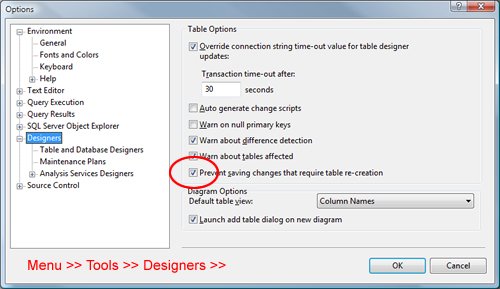Today, we will delve into a very simple issue that one of the Jr. Developers at my organization confronted. I have a preference for T-SQL. According to me, all the developers should always use T-SQL instead of Design feature of SQL Server Management Studio (SSMS). In fact, sound knowledge of T-SQL has the potential to make a huge difference in the development of the developer. One issue with using design mode of SSMS is that it sometimes adds too much overhead to the actual code and locks up the complete database. In the earlier version of SSMS, it was quite common to see that even on doing a small change the whole SSMS got hanged and went unresponsive till the operation was over.
The reason for SSMS to go unresponsive is that when some operations (i.e. adding column, changing datatype of any column, etc) happen, it has to do much more work than the actual operation. Let us now examine an operation where we will add a new column to an already existing table.
- Transaction starts.
- When a new column is added SSMS renames the existing table to temp table.
- After that, it creates a new table with new specification.
- Now, SSMS has two tables: copy of previous table with data and empty table with new structure.
- SSMS now starts moving older data from older table to newer table.
- If there is any error, it rolls back transaction.
- If there is no error, it commits all the previous operations.
- Transaction ends.
This entire operation is very resource intensive and puts lock on SQL Server tables in operation, eventually hanging SSMS.
SQL Server 2008 SSMS has new a feature that averts this issue. SSMS prevents user from running any operation that goes through the above-mentioned process. Let us see an example for the same.
First, create table using the following script in any database.
CREATE TABLE dbo.Table_1
(
ID INT NOT NULL,
First VARCHAR(50) NOT NULL,
Second VARCHAR(50) NOT NULL,
Third VARCHAR(50) NOT NULL
) ON [PRIMARY]
GO
Once the table is created open the table in SSMS by clicking on the table name and selecting “Design.” Try to include another column to the existing table and click on save (CTRL+S). It will prevent it from saving and will emit the following error in popup.
Saving Changes in not permitted. The changes you have made require the following tables to be dropped and re-created. You have either made changes to a table that can’t be re-created or enabled the option Prevent saving changes that require the table to be re-created

I like how SSMS takes stance of displaying warning message and stops user from going further to do operation, thereby preventing hanging of SSMS. However, this feature can cause inconvenience in a situation when one is required to save table using SSMS. If such situation arises, then this feature can be turned off by going to Menu >> Tools >> Options >> Designers >> Uncheck “Prevent Saving changes that require table re-creation”.

This restriction only applies to operation attempted using only SSMS. If modification of tables are attempted using T-SQL in Query Editor, it will work just fine!
Reference : Pinal Dave (https://blog.sqlauthority.com)






71 Comments. Leave new
Thank You Pinal
you rock man :o) thank you
Thanks alot.
Thanks a LOT!
thanks
Thank you.
Thank you!
thank u very much…
Perfect
THANK YOU!
Thanks a lot. Get a lot help from your site.
Thank you Dave. Excellent and was very useful for me.
Thank you! Saved us a lot of time. Excellent blog.
Thanks Dave. This is a better explanation than I had read in other sites. I believe there is a valid reason for why Microsoft made preventing changes through SSMS the default. As I recall, when you make changes like this they don’t get saved to the log and therefore you may run into problems if you ever have to restore the database.
hi thanks for expalantion
Dave, I received a comment her on my blog and would like to make it clear that I put a source link in the post that makes reference to her.
If necessary change the text of the post, but would like to notify you that I use my blog as a repository or library consultation only.
Any problems please look me up.
Sincerely, Zani
My post:
Now it’s 2014. And my SQL Server 2014 came into exactly the same problem. And I came here.
how to the same process in SQL server 2005
Thanks a lot…
thanks a lot .. saved my time on recreation of table or do other experiment to fix this error..